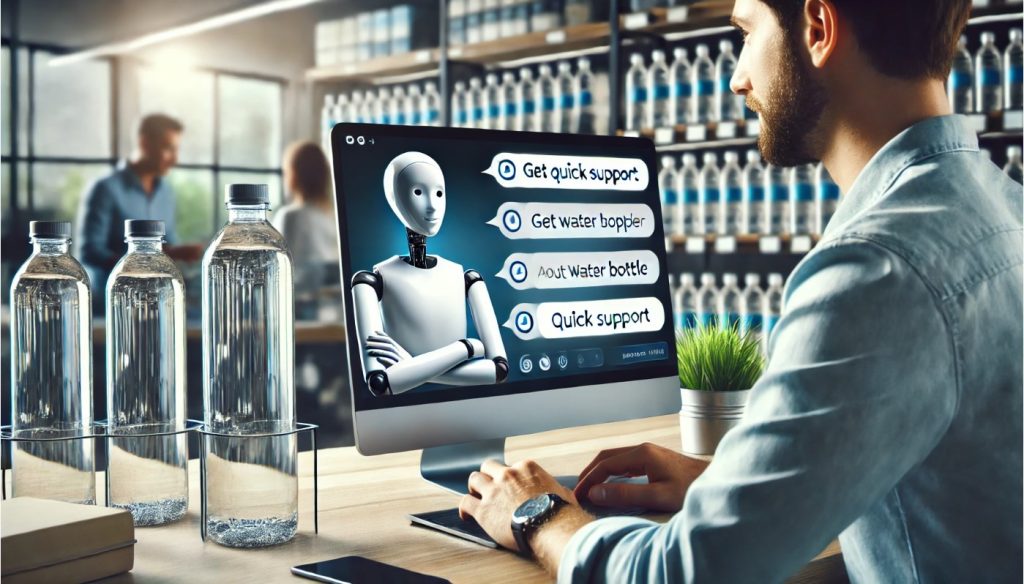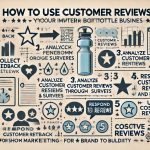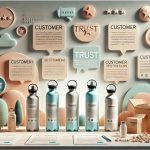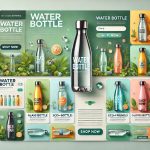In the competitive world of water bottle retail, providing excellent customer service is a crucial element that can make or break your brand. Customers expect quick, efficient, and personalized responses to their inquiries, whether they’re looking for product information, needing assistance with orders, or facing post-purchase concerns. As the demand for speed and efficiency in communication increases, businesses are turning to chatbots as a solution to provide immediate support while keeping operational costs down.
A chatbot is an AI-driven tool that can simulate human conversation, delivering real-time support to customers 24/7. In the water bottle business, chatbots can serve a variety of functions, including answering FAQs, assisting with order tracking, managing returns and exchanges, and even guiding customers through the purchasing process. Integrating a chatbot into your customer support system can enhance user experience, improve customer satisfaction, and ultimately boost sales.
Why Use Chatbots in Customer Support?
Immediate Response and 24/7 Availability
One of the primary reasons businesses incorporate chatbots into their customer service strategies is their ability to provide instant responses. Unlike human agents who are available only during certain hours, chatbots operate 24/7, ensuring that customers always have access to assistance. This is especially important in the global marketplace, where customers may be located in different time zones and require support at any hour of the day or night.
In the water bottle business, this means that whether a customer is browsing your website during the middle of the night or they need urgent assistance during peak hours, a chatbot can handle their inquiries without delay. Instant support can lead to faster resolutions, which improves customer satisfaction and strengthens the relationship between your brand and your customers.
Handling Routine Inquiries
In many cases, customers may have routine inquiries that can be easily answered by a chatbot, such as asking about product details, pricing, shipping information, or return policies. By automating these responses, your team can focus on more complex or unique customer issues, ensuring that high-priority concerns are addressed promptly.
For instance, a chatbot could instantly provide information about the material of your water bottles, their capacity, whether they are BPA-free, or if they are dishwasher safe. If customers are curious about discounts or promotions, a chatbot can automatically share details about current offers.
This reduces the burden on your customer support team, minimizes wait times, and enhances the overall customer experience.
Personalized Customer Experience
Although chatbots are often seen as a tool for automation, they can be programmed to provide personalized interactions. Through customer data and intelligent algorithms, chatbots can tailor conversations based on customer preferences and past interactions, making the experience feel more human-like and individualized.
In the water bottle business, personalized chatbot interactions can include recommending specific products based on customer preferences (e.g., eco-friendly, sports, insulated, etc.), sending personalized discount codes, or providing tailored care tips for maintaining certain bottle materials. By analyzing customer data, chatbots can also remind users of previous purchases, offer subscription services, or even suggest complementary products such as cleaning kits or custom bottle designs.
Cost-Effective Solution
Hiring and training a large team of customer support agents can be expensive, especially if you need 24/7 coverage. Chatbots, on the other hand, are a cost-effective alternative that can handle a significant portion of your customer support workload without the overhead costs associated with human agents.
For smaller businesses or businesses with tight margins, chatbots offer an affordable solution to provide high-quality customer support at scale. As your water bottle business grows, chatbots can be scaled up to handle increased customer demand without requiring additional staff.
Types of Chatbots for Water Bottle Businesses
Rule-Based Chatbots
Rule-based chatbots, also known as scripted chatbots, follow predefined rules to respond to customer queries. These bots are limited in their abilities and can only respond to questions or requests for which they have been specifically programmed. While rule-based chatbots may not have the flexibility of more advanced models, they can still be highly effective for businesses that need to handle routine inquiries.
In the water bottle industry, rule-based chatbots can be used to answer questions such as:
- “What materials are your water bottles made from?”
- “Do you offer discounts for bulk orders?”
- “What’s your return policy for water bottles?”
By programming your chatbot with answers to frequently asked questions (FAQs), you can provide customers with quick, efficient responses and reduce the need for customer service agents to handle repetitive inquiries.
AI-Powered Chatbots
AI-powered chatbots, also known as conversational AI bots, are far more sophisticated than rule-based chatbots. These bots use machine learning algorithms and natural language processing (NLP) to understand and respond to customer queries more intelligently. They can analyze the context of a conversation, learn from past interactions, and provide more dynamic and human-like responses.
For the water bottle business, AI-powered chatbots can be used to:
- Recommend products based on customer preferences or previous purchases.
- Handle complex inquiries, such as customizing a water bottle with a logo for corporate orders.
- Offer personalized customer service, such as following up on order status or assisting with returns and exchanges.
- Engage customers in more natural, dynamic conversations.
These chatbots are highly adaptable and capable of understanding a wider variety of customer inquiries, making them a powerful tool for enhancing customer support.
Hybrid Chatbots
Hybrid chatbots combine elements of both rule-based and AI-powered chatbots. They typically begin with a scripted response system but transition to AI when the conversation becomes more complex. This allows the chatbot to provide fast, automated responses for common inquiries, while also handling more complicated questions using machine learning and natural language processing.
For water bottle businesses, a hybrid chatbot could be used to first direct customers to relevant FAQs and product details and then switch to AI when customers require personalized product recommendations or more detailed troubleshooting.
How to Implement Chatbots for Your Water Bottle Business
Step 1: Define Objectives and Use Cases
Before implementing a chatbot, it’s essential to define the objectives of the chatbot and the types of customer interactions you want to automate. Think about the most common customer questions, issues, and pain points, and decide where the chatbot can add the most value.
For example, in the water bottle business, your objectives might include:
- Automating responses to frequently asked questions, such as product availability, pricing, or material information.
- Assisting with order tracking and shipment inquiries.
- Handling returns, refunds, and exchange requests.
- Offering personalized recommendations or subscription services.
- Providing after-purchase care instructions for different types of water bottles.
Once you’ve identified the key use cases, you can start to design the chatbot’s flow and ensure that it aligns with your customer service goals.
Step 2: Choose the Right Chatbot Platform
Selecting the right platform is crucial to successfully implementing a chatbot for your water bottle business. There are a variety of chatbot development platforms available, each offering different features and integrations. Some popular platforms include:
- Tidio: A user-friendly platform that integrates with websites, Shopify, and other e-commerce platforms. Tidio offers both rule-based and AI-powered chatbots, making it a flexible option for businesses of all sizes.
- Intercom: Known for its powerful AI capabilities and robust customer support features, Intercom allows businesses to create personalized and automated conversations at scale.
- Zendesk: While primarily a customer support platform, Zendesk offers chatbot functionality through its AI-powered Answer Bot. It helps businesses streamline support workflows and offer faster response times.
- ManyChat: Ideal for businesses focused on social media marketing, ManyChat integrates with Facebook Messenger, WhatsApp, and other messaging platforms, making it great for customer interaction.
Choose a platform that integrates seamlessly with your existing website, customer support tools, and e-commerce systems to ensure smooth communication and data management.
Step 3: Create Chatbot Content and Conversation Flows
Once you’ve selected a platform, it’s time to design the conversation flow and create content for your chatbot. Think about the various customer interactions you want to automate and map out the flow of each conversation.
For a water bottle business, here are some potential conversation flows:
- Product Inquiry Flow: A customer asks about the material of a water bottle, and the chatbot responds with options (stainless steel, glass, plastic, etc.) and offers to suggest specific products based on preferences.
- Order Tracking Flow: A customer provides an order number, and the chatbot offers real-time updates on shipment status.
- Return and Exchange Flow: A customer requests to return a bottle, and the chatbot guides them through the return process, including return shipping and refund information.
- Customer Support Flow: A customer has a more complex question, and the chatbot either escalates the issue to a human agent or provides additional resources (e.g., a knowledge base or live chat).
Use concise and friendly language, keeping the tone consistent with your brand. A chatbot should feel approachable and helpful, not robotic.
Step 4: Integrate Chatbots with Other Systems
For a fully functional chatbot that enhances customer support, it’s crucial to integrate it with other systems, such as your customer relationship management (CRM) tools, order management software, and inventory systems. Integration ensures that the chatbot has access to accurate, up-to-date data that can be used to personalize conversations and provide meaningful assistance.
For example:
- If a customer inquires about the status of their order, the chatbot can pull real-time data from your order management system to provide the most current information.
- If a customer is looking for specific water bottles or accessories, the chatbot can access your inventory to provide product availability details.
This integration creates a seamless experience for both customers and support staff, improving efficiency and reducing the need for manual intervention.
Step 5: Continuously Improve Your Chatbot
After your chatbot is live, monitor its performance closely and gather feedback from customers. Chatbots should be continuously improved based on real-world interactions to ensure they provide value to both your business and your customers.
Use analytics to track key metrics such as:
- Response time: How quickly is the chatbot able to respond to customer inquiries?
- Customer satisfaction: Are customers satisfied with the chatbot’s responses and assistance?
- Escalation rate: How often does the chatbot have to escalate inquiries to human agents?
Use this data to refine the chatbot’s conversation flows, improve its responses, and ensure that it’s meeting your customer service goals.
Conclusion
Integrating a chatbot into your water bottle business can transform your customer service operations by providing fast, personalized, and cost-effective support. Whether you’re answering routine questions, assisting with order tracking, or handling complex customer requests, chatbots can help streamline your processes and provide a better customer experience. As the technology behind chatbots continues to evolve, incorporating AI-powered chatbots into your business strategy will become even more essential for staying competitive in the marketplace. By offering quick, efficient, and responsive support, you can build stronger customer relationships, increase satisfaction, and drive repeat business.







